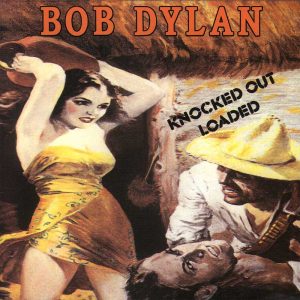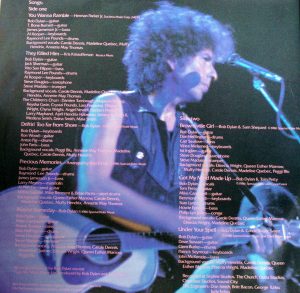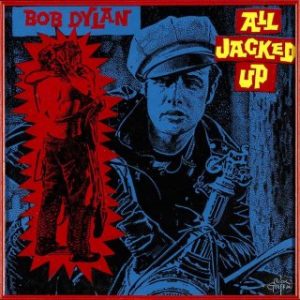by Patrick Roefflaer
- Released July 14, 1986
- Illustration Harry Lemon Pankhurst
- Art-director Charles Sappington
 The cover of Bob Dylan’s 24th studio album is one that reveals its secrets with difficulty.
The cover of Bob Dylan’s 24th studio album is one that reveals its secrets with difficulty.
On the cover is a painting depicting three figures: two men are fighting and a girl is about to smash a jar on the head of one of them. In the background: a mud hut with a straw roof. The scene seems to be set somewhere in the Wild West. The bandido who can expect a headache could be a Mexican and the señorita a sexy dressed Indian.
The proportions of the illustration are incorrect. It seems that the originally rectangular image has been deformed into a square, so that the figures are squat and expanded in width.
At the top, in black-rimmed orange letters, there’s the name Bob Dylan, and diagonally above the two men, the title is in black capital letters: KNOCKED OUT LOADED.
The same image and layout are once more reprised identically on the back.
 Although about 120 people are thanked on the inner cover, the credits remain very vague. The only concrete thing regarding the sleeve is: “Album Art: Charles Sappington”.
Although about 120 people are thanked on the inner cover, the credits remain very vague. The only concrete thing regarding the sleeve is: “Album Art: Charles Sappington”.
In the mid-1990s, Rod MacBeath published a series of articles on the covers under the title ‘Looking Up Dylan’s Sleeves’ in the fanzine The Telegraph. In the fifth part, about Knocked out Loaded, he believes that Charles Sappington based himself on the illustration of a scene from the Western ‘Duel in the Sun’, by King Vidor from 1946. He comes to this conclusion because the I-figure (Bob Dylan) in the song ‘Brownsville Girl’ describes how he saw a movie with Gregory Peck. From the further description, it appears that this concerns The Gunfighter (1950) by Henry King. Peck stars in both Westerns, and his Duel in the Sun co-star Jennifer Jones plays a mestiza Native American.
A tip of the veil will be lifted on May 1, 2009. That day The Houston Chronicle publishes an interview with Charles R. Sappington. You can find it here
When asked whether he made the image, Charles replies:
I created the package. However, the deal was at the time … I promised them I wouldn’t talk about it. There was a reason, and it was legal. They had some legal problems with that cover. I suspect enough time has passed, but I have to stick to my word unless I get approval from the Dylan camp. (Note: Dylan’s camp had no comment.) What I can say is that Bob Dylan supplied the original image and then we distorted it from there.
He also adds that a photographer was originally asked to take some pictures of Dylan and Tom Petty.
 They originally had a photographer shoot some photos of Dylan and Tom Petty. I heard Dylan took a look and threw them all in the trash. The only thing he liked from the shoot was a Polaroid test shot, which is the first thing they gave me. I fiddled with that, but they didn’t care for it, and we went in a different direction. That’s the part I can’t talk about.
They originally had a photographer shoot some photos of Dylan and Tom Petty. I heard Dylan took a look and threw them all in the trash. The only thing he liked from the shoot was a Polaroid test shot, which is the first thing they gave me. I fiddled with that, but they didn’t care for it, and we went in a different direction. That’s the part I can’t talk about.
He does however want to talk about the very long list of thank-you’s.
It didn’t start out that long. It was about 20 names. Bob told me he didn’t want it in this typeset. He wanted it hand-lettered but not calligraphy. I knew exactly what to do. I turned it over to my now ex-wife. She was at UCLA in a landscape architecture program. She was into lettering on drawings, which I thought would be perfect. I sent Bob a sample, and he liked it. But every morning he called with new names to add to the list. The morning it had to go to press he called with five more names. My wife was headed out the door to go to her job, and I said, “Wait, you have to do this before you leave.” She sat down and did it.
When, the day after, this is discussed on the Dylan forum Expecting Rain, there still appears to be confusion whether or not Sappington made the image. He himself (or someone impersonating him) therefore logs into the forum, under the pseudonym Notherelong, to make this clear:
First of all the credit on the album says “Album Art: Charles Sappington” not picture by Charles Sappington. Second the original image is NOT from a Gregory Peck Movie. As to where it originated, you will have to ask BD.
[…]
Sincerely
Charles Sappington
Pulp Fiction
It will take another five years for the truth to come to light. In June 2014, top Bob Dylan researcher Scott Warmuth posts on his Facebook page, without comment, a cover of a pulp magazine from the Spicy-Adventure Stories series. Dylan fans, of course, immediately recognize the image as the long-sought source for the image on the cover of Knocked Out Loaded.
It concerns the story Daughters of Doom, written by E. Hoffman Price, published in January 1939 and illustrated by H.L. Parkhust.
Harry Lemon Parkhurst, like Robert Zimmerman, appears to be from Minneapolis, MN. He was born there in 1876, but moved with his parents to Chicago, where he studied at the Art Institute. In 1899 he moved to New York where he became a freelance illustrator for all kinds of magazines. He is doing well until the market collapses due to the Great Depression.
He is forced to switch to illustrating pulp magazines. They are sold in stalls and therefore do not rely on advertisers. Parkhurst continues to work as long as his eyes allow. He spent the last years of his life at the Institute of the Blind in Huntington, NY, where he died in 1962 at the age of 86.
Dylan found the illustration in a book: The Pulps: Fifty Years of American Pop Culture, curated by Tony Goodstone – the first man on the list of people to be thanked on the inner sleeve of Knocked Out Loaded.
In her memoir, published in 2016, as Seeing The Real You At Last: Life And Love On The Road With Bob Dylan, Bob’s then-girlfriend Britta Lee Shain tells of the day the artwork was chosen:
[Bob] is now looking for an album cover, sort of a ’50s pulp detective magazine thing, and when I mention that I have this friend, Tony Goodstone, with an incredible collection of old movie posters, Bob says, ‘Get him up here. Tomorrow.’
Tony is this heavyset actor, writer, and antiques restorer — he owns a ’58 Fairlane convertible with a working retractable top — who I met at a play in North Hollywood. He has literally written the book on pulp art: a substantive tome entitled The Pulps: Fifty Years Of Pop Culture. His best friend is screenwriter Terry Southern, who wrote the scripts for Dr. Strangelove, Barbarella, and Easy Rider. Tony had offered to read my novel, Detours, which opens with a quote from the Maltese Falcon about ‘the stuff that dreams are made of,’ and the first time he came to my house, he showed up carrying a replica of the famed fake falcon wrapped in newspaper and string, just like in the movie.
Bob and Tony hit it off right away — which is one of life’s great thrills for Tony — and at a meeting that takes place on Bob’s deck in Malibu, the three of us sit at the round redwood table, pouring over possible photographs for the album cover. ‘That’s the one!’ Bob says, picking out a pulpy piece from the 40s depicting a sarong-clad woman bashing an urn over some guy’s head.
“I’ll check out the rights,” Tony volunteers.
“Let ’em sue us,” Dylan says.
In the thank-you list on the inner sleeve of the album, Britta Lee Shain is probably listed as ‘Rita & Britta’. Incidentally, the list contains a striking number of female names: Annette, Vanessa, Clara, Helena, Nicole, Sharon, Carol … Some are given a full name (Carole Childs, Clydie King, …), while others require a cryptic description (The Baroness, The Duchess, …).
In retrospect, there are some names that ring a bell:
‘Desiree’ is Desiree Gabrielle Dennis-Dylan, the daughter the singer has with his second (?) wife Carolyn Dennis. Her existence was not known at the time.
Desiree might also be listed as ‘Baby Boo Boo’. A baby boo boo is urban slang for an unexpected pregnancy. Another contender for this designation is ‘Narette, who is rumoured to be his daughter with Clydie King.
Narette also appears with the acknowledgments in his Lyrics 1962-1985.
Rick Griffin
Knocked Out Loaded continues to surprise.
In May 2008 an earlier cover design for the record, made by Rick Griffin, appears at a rock auction at Bonhams.
Griffin was the legendary designer of a colourful psychedelic concert poster in the San Francisco scene of the late 1960s. He also designed a number of covers for people like Neil Young (On the Beach), Jackson Browne (Late for the Sky), but most of all he collaborated a lot with Grateful Dead.
 A big surprise is that Knocked Out Loaded was first called All Jacked Up.
A big surprise is that Knocked Out Loaded was first called All Jacked Up.
The promotional text from the catalog states:
“This is a design for an album by Bob Dylan. After being approached by Dylan’s management to design the cover, Rick listened to the music that would be on the record and designed an emotionally intense vision, with a strong contrast between Marlon Brando’s dark blue, rebellious cool, ” The Wild One ‘(1983), opposite the title’s passionate red. Rick was jacked up at the time. He had just bought a new Harley Davidson motorcycle, hence the autobiographical reference in the image. “
Griffin died in 1991, three days after an accident with the same motorcycle
Junco Partner
Finally, the title. All Jacked Up had to make way for Knocked Out Loaded.
Bob later reveals that he got the phrase ‘Knocked out loaded’ from an old blues song from the New Orleans area, called ‘Junco Partner.’
“Down the road came a junco partner
For he was loaded as can be.
He was knocked out, knocked out loaded
He was a-wobblin’ all over the street.”
The song is best known thanks to the first recording by James Booker (1951) and the cover (s) by The Clash on their 1981 album Sandinista. This version above also comes from 1951
This is the 12th in our unique series of articles on the artwork on Bob Dylan’s albums. You can find links to the earlier articles on the Album Artwork page.
What else is on the site?
We have a very lively discussion group “Untold Dylan” on Facebook with over 3400 active members. (Try imagining a place where it is always safe and warm). Just type the phrase “Untold Dylan” in, on your Facebook page or follow this link
You’ll find some notes about our latest posts arranged by themes and subjects on the home page of this site. You can also see details of our main sections on this site at the top of this page under the picture.
The index to all the 598 Dylan compositions and co-compositions that we have found on the A to Z page.
If you are interested in Dylan’s work from a particular year or era, your best place to start is Bob Dylan year by year.
On the other hand if you would like to write for this website, or indeed have an idea for a series of articles that the regular writers might want to have a go at, please do drop a line with details of your idea, or if you prefer, a whole article to Tony@schools.co.uk
And please do note our friends at The Bob Dylan Project, which lists every Dylan song in alphabetical order, and has links to licensed recordings and performances by Dylan and by other artists, plus links back to our reviews (which we do appreciate).

Very interesting!
Thanks Larry.
Great article, Patrick Roefflaer,
I enjoyed reading again how Bob is engaged in all aspects of his album covers, and credits! Letter(?) from Charles Sappington is great. Also the list of what appears to be Bob;s offspring daughters who by this time would have their own children or grand children!
I especially liked that you tracked down that info on Bob’s reference to using the lyrics from that 1951 recording of Junco Partner “knocked out and loaded” for his album instead of Jacked up! I can really see Bob preferring that as soon as it hit him. Thanks for including the song as well.
nissi
You’re welcome, Denise. Your comment is much apperciated.
“if I had a million dollars …I buy you a house … ” : Bare Naked Ladies
LOL Larry!